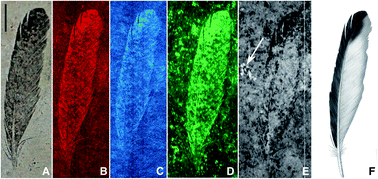
Archaeopteryx lithographica single feather, visible light and SRS-XRF false colour images
Researchers at the University of Manchester discovered that the world’s oldest bird was not black, as previously thought.
Phillip Manning and colleagues used synchrotron rapid scanning X-ray fluorescence (SRS-XRF) combined with sulphur X-ray absorption near edge structure (XANES) to examine the presence of trace elements in the feathers of Archaeopteryx, an iconic fossil widely studied to understand bird evolution.
The importance of colour of in the natural selection of bird plumage was first acknowledged by Charles Darwin. The colour of bird plumage is in fact a function of selection processes, varies depending on age, sex, diet and is crucial for camouflage and marking the territories.
This study suggests a “possible visual role for pigments in the feathers of Archaeopteryx acting as a fitness criterion in the natural selection of this species, and having an impact on evolution of pigmentation in this and other feathered theropod dinosaurs”, write the authors.
The paper, ‘Synchrotron-based chemical imaging reveals plumage patterns in a 150 million year old bird’, was published in the themed issue of JAAS on Elemental Imaging and has featured in an article in the Daily Mail today. This paper will be free to read for 6 weeks.
Synchrotron-based chemical imaging reveals plumage patterns in a 150 million year old early bird
Phillip. L. Manning et al.,
J. Anal. At. Spectrom., 2013, 28, 1024-1030
DOI: 10.1039/C3JA50077B










